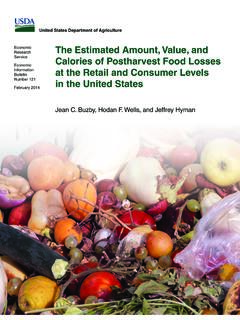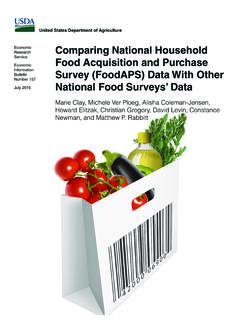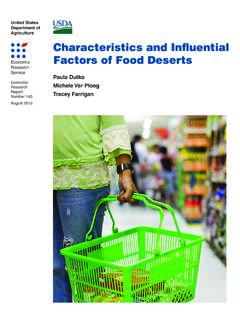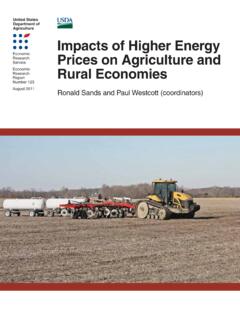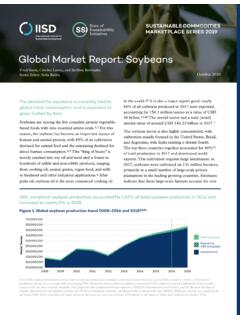Transcription of United States Department of Agriculture
1 Jorge Fernandez-CornejoRichard NehringCraig OsteenSeth WechslerAndrew MartinAlex VialouEconomic Research ServiceEconomic Information Bulletin Number 124 May 2014 United States Department of AgriculturePesticide Use in Agriculture : 21 Selected Crops, 1960-2008 Economic Research Service Department of Agriculture (USDA) prohibits discrimination in all its programs and activities on the basis of race, color, national origin, age, disability, and, where applicable, sex, marital status, familial status, parental status, religion, sexual orientation, genetic information, political beliefs, reprisal, or because all or a part of an individual s income is derived from any public assistance program. (Not all prohibited bases apply to all programs.) Persons with disabilities who require alternative means for communication of program information (Braille, large print, audiotape, etc.)
2 Should contact USDA s TARGET Center at (202) 720-2600 (voice and TDD). To file a complaint of discrimination write to USDA, Director, Office of Civil Rights, 1400 Independence Avenue, , Washington, 20250-9410 or call (800) 795-3272 (voice) or (202) 720-6382 (TDD). USDA is an equal opportunity provider and States Department of AgricultureCover images: of commercial and trade names does not imply approval or constitute endorsement by USDA. Access this report Download the charts contained in this report: Go to the report s index page eib-economic-information- Click on the bulleted item Download Open the chart you want, then save it to your computerRecommended citation format for this publication:Fernandez-Cornejo, Jorge, Richard Nehring, Craig Osteen, Seth Wechsler, Andrew Martin, and Alex Vialou.
3 Pesticide Use in Agriculture : 21 Selected Crops, 1960-2008, EIB-124, Department of Agriculture , Economic Research Service, May States Department of AgricultureEconomic Research ServiceEconomic Information Bulletin Number 124 May 2014 AbstractPesticide use has changed considerably over the past five decades. Rapid growth char-acterized the first 20 years, ending in 1981. The total quantity of pesticides applied to the 21 crops analyzed grew from 196 million pounds of pesticide active ingredients in 1960 to 632 million pounds in 1981. Improvements in the types and modes of action of active ingredients applied along with small annual fluctuations resulted in a slight down-ward trend in pesticide use to 516 million pounds in 2008. These changes were driven by economic factors that determined crop and input prices and were influenced by pest pressures, environmental and weather conditions, crop acreages, agricultural practices (including adoption of genetically engineered crops), access to land-grant extension personnel and crop consultants, the cost-effectiveness of pesticides and other practices in protecting crop yields and quality, technological innovations in pest management systems/practices, and environmental and health regulations.
4 Emerging pest management policy issues include the development of glyphosate-resistant weed populations associated with the large increase in glyphosate use since the late 1990s, the development of Bt-resistant western corn rootworm in some areas, and the arrival of invasive or exotic pest species, such as soybean aphid and soybean rust, which can influence pesticide use patterns and the development of Integrated Pest Management authors thank Marc Ribaudo and James MacDonald, USDA, Economic Research Service; Sheryl Kunickis, David Epstein, Julius Fajardo, and Teung Chin, USDA, Office of Pest Management Policy; Cynthia Doucoure, EPA; Scott Swinton, Michigan State University; and David Shaw, Mississippi State University. We are grateful to Dale Simms for valuable editorial assistance and Cynthia A.
5 Ray for graphics and Fernandez-Cornejo, Richard Nehring, Craig Osteen, Seth Wechsler, Andrew Martin, and Alex VialouPesticide Use in Agriculture : 21 Selected Crops, 1960-2008ii Pesticide Use in Agriculture : 21 Selected Crops, 1960-2008, EIB-124 Economic Research Service/USDAC ontentsSummary ..iiiIntroduction ..1 Data ..2 Box 1 Agricultural Pests and Pesticides ..2 Economic Factors Influencing Pesticide Use..6 Farmers Choice of Pesticides ..7 Box 2 Pesticide Expenditures ..9 Trends in Pesticide Use ..11 Early Growth Driven by Herbicide Adoption for Major Crops ..11 Herbicide Adoption Driven by Relative Prices ..15 Stabilization of Herbicide Use and Decline in Insecticide Use Driven by Demand and Supply Factors ..16 Box 3 Pesticide Prices and Relative Price Trends.
6 17 Herbicide-Tolerant Crops Transform Herbicide Mix ..19 Insecticide Use Declines as Herbicides Grow ..22 Fungicides Used Mainly on Fruits and Vegetables ..26 Cotton and Potatoes Are Major Users of Other Pesticides ..26 Five Major Crops Account for Four-Fifths of Pesticides Use ..27 Pesticide Quality ..27 Box 4 Quality Adjustment of Pesticides ..28 Conclusion ..30 References ..32 Appendix 1 Human Health Effects and Pesticide Regulation ..40 Appendix 2 Data Sources ..42 Appendix 3 The Economics of Pesticide Use ..59 Appendix 4 Trends in Pesticide Use on Five Major Crops ..62 corn Pesticide Trends ..62 soybean Pesticide Trends ..66 Cotton Pesticide Trends ..69 Potato Pesticide Trends ..72 Wheat Pesticide Trends .. Is the Issue? Pesticides including herbicides, insecticides, and fungicides have contributed to substantial increases in crop yields over the past five decades.
7 Properly applied, pesticides contribute to higher yields and improved product quality by controlling weeds, insects, nematodes, and plant pathogens. In addition, herbicides reduce the amount of labor, machinery, and fuel used for mechanical weed control. However, because pesticides may possess toxic properties, their use often prompts concern about human health and environmental consequences. The examination of pesticide use trends is critical for informed pesticide policy debate and science-based decisions. This report analyzes pesticide use trends using a new pesticide database compiled from USDA and proprietary data, focusing on 21 Did the Study Find?Total pesticide use, as well as the specific active ingredients used (for example, with novel target sites of action or improved toxicological profiles), has changed considerably over the past five use on the 21 crops analyzed in this report rose rapidly from 196 million pounds of active ingredient ( ) in 1960 to 632 million pounds in 1981, largely because of the increased share of planted acres treated with herbicides to control weeds.
8 In addition, the total planted acreage of corn , wheat, and, in particular, soybeans increased from the early 1960s to early 1980s, which further increased herbicide use. Most acres planted with major crops (particularly corn and soybeans) were already being treated with herbicides by 1980, so total pesticide use has since trended slightly downward driven by other factors, to 516 million pounds in 2008 (the most recent year for which we have enough complete data). The rapid adoption of herbicides was mainly driven by relative price declines that helped reduce the cost of herbicides relative to other pest control practices and encouraged substitution of herbi-cides for labor, fuel, and machinery use in mechanical weed control. The fluctuations in pesticide use over 1982-2008 were driven by several factors, including changes in planted acreage, crop and input prices, weather, pesticide regulations, and the introduction of new pesticides and genetically engineered (GE) seed.
9 Changes in the acreages of corn , cotton, soybeans, potatoes, and wheat contributed to fluctuations in pesticide use from 1981 to 2008, with many high and low years in herbicide and pesticide use coinciding with high and low years in total acreage of these pesticide types applied by farmers for the 21 crops analyzed changed considerably from 1960 to 2008. Insecticides accounted for 58 percent of pounds applied in 1960, but only 6 percent in 2008. On the other hand, herbicides accounted for 18 percent of the pounds applied in 1960 but 76 percent by 2008. The growth of herbicide use is also illustrated by the percent of acres treated. United States Department of AgricultureA report summary from the Economic Research ServiceMay 2014 ERS is a primary source of economic research and analysis from the Department of Agriculture , providing timely informa-tion on economic and policy issues related to Agriculture , food, the environment, and rural the full report at Fernandez-CornejoRichard NehringCraig OsteenSeth WechslerAndrew MartinAlex VialouEconomic Research ServiceEconomic Information Bulletin Number 124 May 2014 United States Department of AgriculturePesticide Use in Agriculture : 21 Selected Crops, 1960-2008 Jorge Fernandez-Cornejo, Richard Nehring, Craig Osteen, Seth Wechsler, Andrew Martin, and Alex VialouPesticide Use in Agriculture .
10 21 Selected Crops, 1960-2008 Approximately 5-10 percent of corn , wheat, and cotton acres were treated with herbicides in 1952. By 1980, herbicide use had reached 90-99 percent of corn , cotton, and soybean acres planted. Notably, the four most heavily used active ingredients in 2008 (glyphosate, atrazine, acetochlor, and metolachlor) were all herbicides. Fungicides share of pesticide use has remained at 7 percent or less since 1971, down from 11-13 percent in the early 1960s. Other pesti-cides which include soil fumigants, desiccants, harvest aids, and plant growth regulators generally accounted for 5-11 percent of total pesticide use from 1960 to 1992, increased to 17 percent of use in 2002, and then declined to 13 percent in t a l pesticide expenditures in Agriculture reached close to $12 billion in 2008, a 5-fold increase in real terms (adjusted for inflation) since 1960, but well below the $ peak reached in 2008, corn , soybeans, cotton, wheat, and potatoes accounted for about 80 percent of the pesticide quantity (measured in pounds of ) applied to the 21 crops examined.
